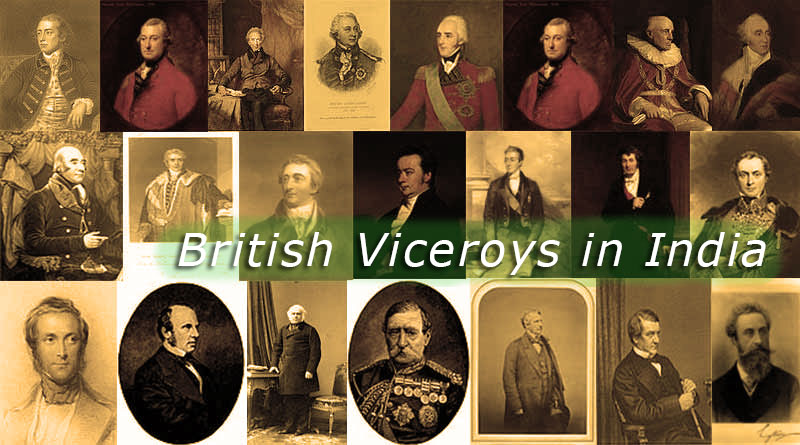
TOPIC 5.9 VICEROYS OF INDIA
1.Lord Canning (1856-1862)
Revolt of 1857
Universities of Calcutta, Bombay and Madras were opened in 1857.
He was last Governor-General appointed by the East India Company and the First Viceroy.
Passed the Government of India Act 1858, which ended the rule of the East India Company.
The Doctrine of Lapse was withdrawn. The Indian Penal Code (1859) was passed. Income tax was introduced for the first time in 1858.
The Indigo riots in Bengal.
The Indian Councils Act of 1861 was passed, which proved to be a landmark in the constitutional history of India.
Indian High Court Act, (1861). Under this act, High Courts were opened in 1865.
Bombay and Madras were founded in 1857.
2.Sir John Lawrence (1864-69)
High Courts were established at Calcutta, Bombay and Madras in 1865. War with Bhutan in 1865.
The Punjab Tenancy Act was passed.
Lord Ripon (1880-1884)
He was appointed by the Liberal Party under Gladstone. Repealed the Vernacular Press Act In 1882.
The first Factory Act came in 1881 (Improve the labour condition). In rural areas, Local Boards were set-up in 1889, the Madras Local Board Act, was passed. He was famously known as “Father of Local Self Government”.
First Official Census in India (1881).
Famine code was adopted (1883).
Appointed Hunter Commission for Educational reforms in 1882.
Ilbert Bill Controversy (1883-84), which empowered Indian Judges to inquire into European cases.
Foundation of Punjab University.
3.Lord Curzon (1899-1905)
Appointed a Police Commission in 1902 under Andrew Frazer.
Universities Commission appointed in 1902, under Thomas Railey.
Indian Universities Act, passed in 1904.
Famine Commission under Macdonell.
A new Department of Commerce and Industry was established.
Partition of Bengal (16th October, 1905).
The rising of the frontier tribes in 1897-98 led him to create the North-Western Frontier Province.
He passed the Ancient Monuments Protection Act, (1904) to restore India’s cultural heritage. Thus, the Archaeological Survey of India was established.
Passed the Indian Coinage and Paper Currency Act, (1899) and put India on a gold standard.
PUSA Agricultural Institute in 1903.
4.Lord Minto –II (1910-1910)
Swadeshi Movement.
Surat split (split in Congress between the moderates and the extremists,1907).
Indian Councils Act, 1909 and Morley-Morley-Minto Reforms.
Foundation of Muslim League, 1906.
Newspapers Act, 1908.
Lord Hardinge-II (1910-1916)
Annulment of the Partition of Bengal in 1911.
Bomb was thrown at Hardinge near Chandni Chowk, but escaped unhurt.
Transfer of capital from Calcutta to DeLhi in 1911.
Darbar in Delhi and Coronation of George V in 1911.
In 1912, Behar and Orissa separated from Bengal and became a new state.
Establishment of Hindu Mahasabha by Madan Mohan Malviya (1915).
Gandhiji came back to India from / South Africa (1915)
5.Lord Chelmsford (1916-21)
Government of India Act, 1919 also known as Montague-Chelmsford Reforms.
Repressive Rowlatt Act, (1919).
Jallianwala Bagh Massacre (13th April, 1919).
Home Rule Movement both by Tilak and Annie Beasant.
Sadler Commission on Education in 1917.
Appointment of Hunter Commission to look into Jallianwala Bagh Tragedy.
Chambers of Prince, 1921, established.
Non Cooperation Movement Started, Khilafat movement initiated.
An Indian Sir SP Sinha was appointed as the Governor of Bengal.
Death of Tilak (1920).
6.Lord Irwin (1926-1931)
The Simon Commission visited India in 1928. Butler Commission in 1927.
Deepawali declaration by Lord Irwin (1929).
All India Youth Congress, 1928.
Nehru Report, 1928.
Lahore Session of the Congress. (1929) and Poorna Swaraj declaration.
First Round Table Conference 1930. Congress boycotted it.
Civil Disobedience Movement, 1930 started with.
Dandi March (12th March, 1930).
Gandhi-irwin Pact, 5th March, 1931.
Sharda Act, 1929 under which the marriageable age of girls (14 years and boys (18 years) was raised.
Jawaharlal Nehru and Subhash Chandra Bose founded the Independence of India League.
7.Lord Wellington (1931-1936)
Second and Third Round Table Conferences.
Communal Award by Mcdonald (British PM). Government of India Act, 1935.
The Poona Pact was signed.
During his period Orissa was separated from Bihar (1936) and a new province Sind was created (1936). Burma separated from India as well in 1935.
All India Kisan Sabha, 1936.
Foundation of Congress Socialist Party 1934.
8.Lord Mountbatten (March to August, 1947)
3 rd June plan.
Last British Viceroy of British India.
First Governor-General of free India.
Boundary commissions under Radcliffe.
Introduction of Indian Independence Bill in the House of Commons.
In February 1947, Mountbatten was appointed Viceroy and Governor-General of India and oversaw the Partition of India into India and Pakistan. He then served as the first Governor-General of the Union of India until June 1948 and played a significant role in persuading princely states to accede to India
9.C Rajagopalachari
Last Governor-General of India.
The only Indian Governor-General to remain in office from 21st June, 1948 to 25th January 1950.
